Research Results
Science and Technology for Society
Discovery of a big void in Khufu's Pyramid by observation of cosmic-ray muons FY2018
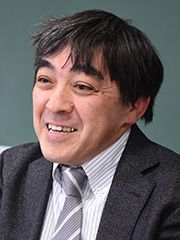
- Mitsuhiro Nakamura (Professor, Advanced Measurement Technology Center, Institute of Materials and Systems for Sustainability, Nagoya University)
- Development of Advanced Measurement and Analysis Systems
- Elemental Technology Type "Development of Nuclear Emulsion Films Elemental Technology for Seeing Through Large Buildings at High Speed" Advanced Device Development Type "Development of High-Precision Cosmic Ray Radiography Systems using Nuclear Emulsion Films" 2016-2020)
To see through buildings non-destructively
The pyramids of Egypt are the world' s oldest stone buildings, and the largest of these is the Great Pyramid of Giza, built around 4,500 years ago for the Pharaoh Khufu, which stands at approximately 150m. News that a big void exceeding 30m in length was discovered inside the pyramid astounded people the world over when announced in the online version of the English-language science journal, "Nature." The void was discovered with cosmic-ray muon radiography, using nuclear emulsion films, as developed by Professor Mitsuhiro Nakamura and others.
Probably the very first thing that comes to mind as a fluoroscope technology is X-ray photography. ut X-rays cannot image things beyond the thickness that the rays penetrate. So what should be used to see through huge structures, such as into building interiors and archaeological sites? The answer to this is "muons," which are one of the types of particle that rain down on us from the space. They have far higher energy than X-rays, and are able to penetrate even enormous structures.
A unique type of film called "nuclear emulsion films" is used to record the muons. In his laboratory, Professor Nakamura has employed "nuclear emulsion films" to attain numerous positive results in elementary particle research, such as with neutrinos. The team of Professor Nakamura and others commenced their research in around 2007, on the assumption that since muons are also elementary particles, cosmic-ray muon radiography may be possible if "nuclear emulsion films" is employed. To date, fluoroscope technology using "nuclear emulsion films" has proven successful for seeing into a range of things, from volcanoes to pyramids and nuclear reactors, and so has been attracting substantial interest as an exclusive, one-of-a-kind technology currently possible to just Professor Nakamura and his team, out of the whole world.
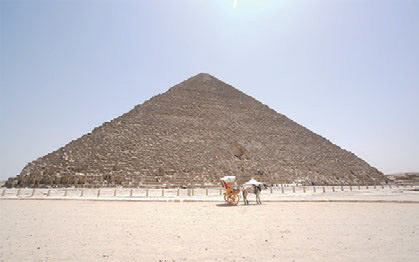
Pyramid of Khufu photographed from the North ©Kunihiro Morishima
From conventional technology to the state of the art
"Nuclear emulsion films" has been in use for a great many years, which the reader will recognize if he or she thinks about photographic film for X-ray photography. The flight path of particles is recorded by the applicatiion of a very thin layer of emulsion, approximately 0.3mm, onto a clear plastic sheet. Of course, because the subject of interest is elementary particles, a hight level of performance is required. In the case of muon paths, recording is possible at high precisions below 1µm (0.0001mm).
Furthermore, the technology benefits significantly from being lightweight, compact and re uiring no electricity, so can be used even outdoors, or in confined spaces. However, there is a major challenge, namely the enormous amount of time it takes to read muons.
Professor Nakamura and his team have succeeded in developing a unique ultra-high-speed reader that can digitize data at a rate 100 times that of previous technology, within the JST's program "Development of Advanced Measurement and Analysis Systems" in which they have been involved since 2011. They succeeded in shortening the total time from measurement through analysis substantially, making it possible to conduct fluoroscopy experiments in many large structures.
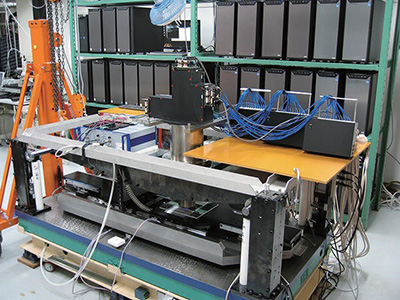
External view of automatic reading technology
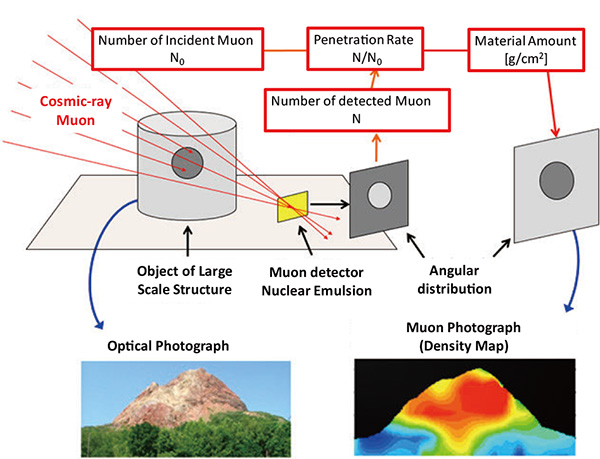
Principle behind the muon radiography system
Technology developed in Japan draws attention from the world
The international project "Scan Pyramids" commenced in 2015 to look at the group of pyramids in Egypt. Various cutting-edge technologies have been used so that damage to subjects is avoided during their examination. Assistant Professor of Nagoya University, Kunihiro Morishima, a member of Professor Nakamura' s team, was among those who joined the project. Since the cosmic-ray muon radiography of Professor Nakamura' s team, used in the project, can examine a wide area, and with great precision, there were high hopes for it to enable the discovery of new spaces in the Pyramid. Professor Morishima set the "nuclear emulsion films" in the Queen' s Chamber, in the center of Khufu' s Pyramid, and analyzed 11 million recorded muons. The results showed a place into which a large number of muons flew, and thereby ascertained that there was a big void that was previously unknown. It is possible that this space is Khufu' s King' s Chamber, which has not yet been found, and there are plans to investigate it further, to examine finer, more detailed structure, in the near future.
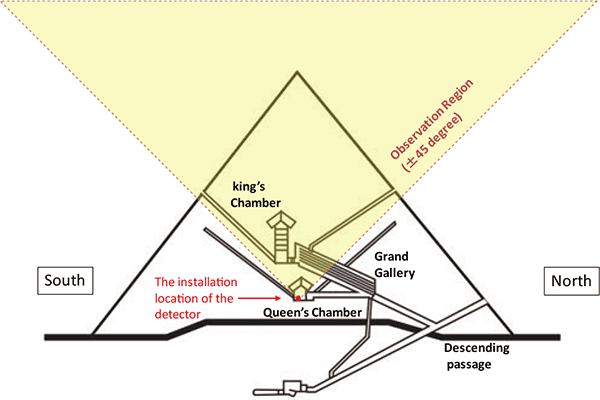
Cross-section of the Pyramid. Red part is the set-up location
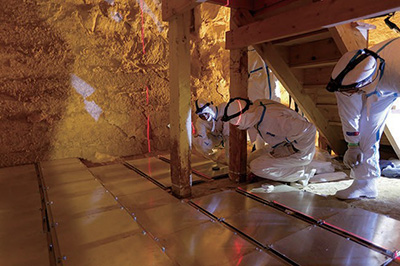
Setting up the nuclear emulsion films within the Bent Pyramid
© Scan Pyramids Mission / Ph. Bourseiller
Expectation as a social infrastructure inspection technology, for volcano observation, underground caves, and more
Development of this cosmic-ray muon radiography is ongoing under the JST program, to strive for higher precisions and systematization. There are more applications for this technology than simply the investigation of pyramids and other ruins. or example, it was used to observe the interior of the reactors damaged by the Great ast Japan arth uake, confirming that there had been a core meltdown. Experiments are underway to investigate caves, to prevent road cave-ins in advance, and to ascertain the magma situation in volcanoes, to help in forecasting eruptions. It is being considered now for use in investigating Mount uji in the future. This was originally foundational research for observing elementary particles, but it looks set to be of use in the activities of us researchers in ways we have yet to imagine.
